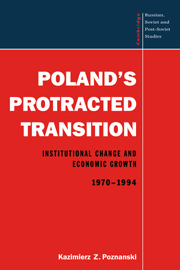Book contents
- Frontmatter
- Contents
- Preface
- Introduction: Research agenda, conceptual model and principal findings
- Part I Imperfect decentralization, broken political contracts and foreign-debt crisis
- Part II Economic reforms, divided society and ‘growth fatigue’
- 4 Anti-crisis policies and elusive economic recovery
- 5 Foreign trade developments: underutilized potential
- 6 Political struggles and economic malaise
- Part III Communist legacy, ‘shock therapy’ and economic recession
- Appendix
- Notes
- References
- Index
- Titles in the series
4 - Anti-crisis policies and elusive economic recovery
Published online by Cambridge University Press: 29 October 2009
- Frontmatter
- Contents
- Preface
- Introduction: Research agenda, conceptual model and principal findings
- Part I Imperfect decentralization, broken political contracts and foreign-debt crisis
- Part II Economic reforms, divided society and ‘growth fatigue’
- 4 Anti-crisis policies and elusive economic recovery
- 5 Foreign trade developments: underutilized potential
- 6 Political struggles and economic malaise
- Part III Communist legacy, ‘shock therapy’ and economic recession
- Appendix
- Notes
- References
- Index
- Titles in the series
Summary
In our effort to reconstruct the developments during the import-led growth of Gierek, we have uncovered a certain causal model, which helps to account for the behavior of Poland's economy in those years. We found that the economic crisis at the end of that period, while accompanied by a debt crisis, seemed largely related to imbalances that emerged in the domestic sector. These imbalances, in turn, could be linked to changes in the economic system as a framework within which government policies were conducted. Changes in the economic system, finally, were traced to the political scene, or shifts in the relative power of particular players, within the party/state and outside of it. In this opening chapter of the second part of the book, we pursue a similar line of analysis to test the validity of that model after the 1981 state of war and provide ground for its further, more specific examination in the other two chapters that make up the rest of this part.
If the causality discovered in the previous part is found in the post martial law period, this would suggest that this period should be viewed, at least in general terms, as an extension of the previous years. The pattern of economic growth in this period seems to actually suggest that we are dealing indeed with a case of continuity in change. When in 1982, following the imposition of martial law, Jaruzelski's government restored direct control over enterprises and imposed harsh monetary measures, it looked as if Poland's economy was on a new long-term track.
- Type
- Chapter
- Information
- Poland's Protracted TransitionInstitutional Change and Economic Growth, 1970–1994, pp. 83 - 114Publisher: Cambridge University PressPrint publication year: 1997



